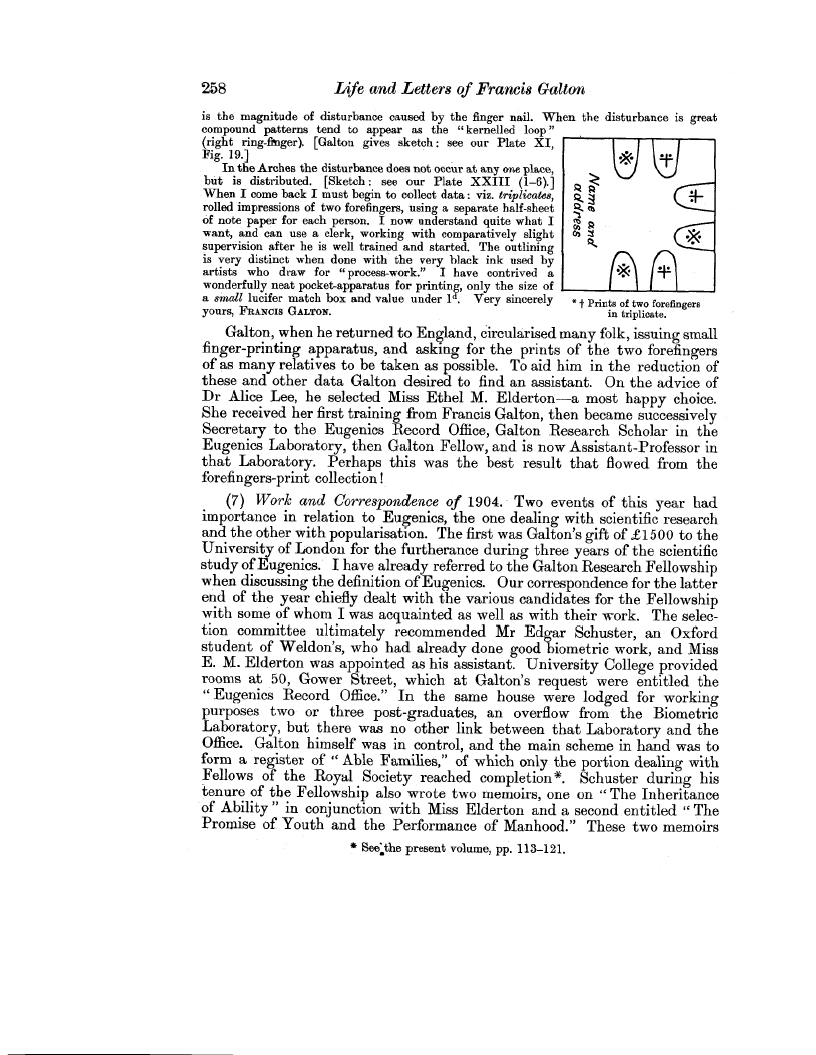| ||||||

OCR Rendition - approximate
258 Life and Letters of Francis Galton is the magnitude of disturbance caused by the finger nail. When the disturbance is great compound patterns tend to appear as the "kernelled loop" (right ring-fnger). [Galton gives sketch : see our Plate XI, Fig. 19.] X In the Arches the disturbance does not occur at any one place, v U but is distributed. [Sketch : see our Plate XXIII (1-6).] Q R When I come back I must begin to collect data : viz. triplicates, rolled impressions of two forefingers, using a separate half-sheet -0,% of note paper for each person. I now understand quite what I R want, and can use a clerk, working with comparatively slight C : X supervision after he is well trained and started. The outlining is very distinct when done with the very black ink used by artists who draw for "process-work." I have contrived a X wonderfully neat pocket-apparatus for printing, only the size of a small lucifer match box and value under ld. Very sincerely * t prints of two forefingers yours, FRANCIS GALTON. in triplicate. Galton, when he returned to England, circularised many folk, issuing small finger-printing apparatus, and asking for the prints of the two forefingers of as many relatives to be taken as possible. To aid him in the reduction of these and other data Galton desired to find an assistant. On the advice of Dr Alice Lee, he selected Miss Ethel M. Elderton-a most happy choice. She received her first training from Francis Galton, then became successively Secretary to the Eugenics Record Office, Galton Research Scholar in the Eugenics Laboratory, then Galton Fellow, and is now Assistant-Professor in that Laboratory. Perhaps this was the best result that flowed from the forefingers-print collection ! (7) Work and Correspondence of 1904. Two events of this year had importance in relation to Eugenics, the one dealing with scientific research and the other with popularisation. The first was Galton's gift of £1500 to the University of London for the furtherance during three years of the scientific study of Eugenics. I have already referred to the Galton Research Fellowship when discussing the definition of Eugenics. Our correspondence for the latter end of the year chiefly dealt with the various candidates for the Fellowship with some of whom I was acquainted as well as with their work. The selection committee ultimately recommended Mr Edgar Schuster, an Oxford student of Weldon's, who had already done good biometric work, and Miss E. M. Elderton was appointed as his assistant. University College provided rooms at 50, Gower Street, which at Galton's request were entitled the " Eugenics Record Office." In the same house were lodged for working purposes two or three post-graduates, an overflow from the Biometric Laboratory, but there was no other link between that Laboratory and the Office. Galton himself was in control, and the main scheme in hand was to form a register of Able Families," of which only the portion dealing with Fellows of the Royal Society reached completion*. Schuster during his tenure of the Fellowship also wrote two memoirs, one on " The Inheritance of Ability " in conjunction with Miss Elderton and a second entitled " The Promise of Youth and the Performance of Manhood." These two memoirs * Seer he present volume, pp. 113-121.
|